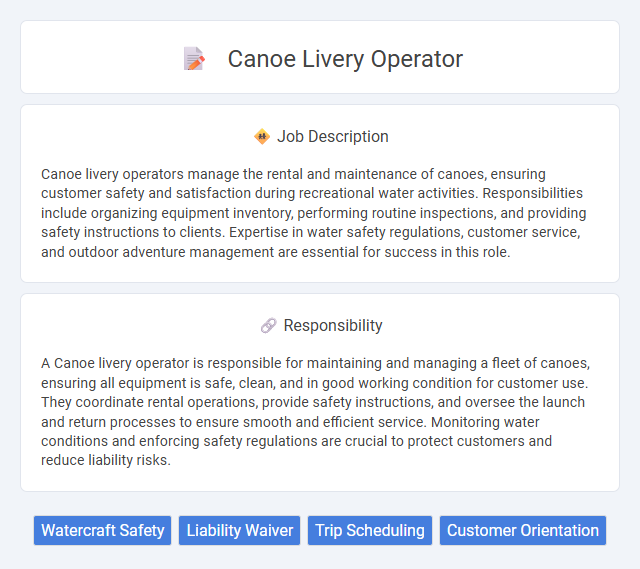
Canoe livery operators manage the rental and maintenance of canoes, ensuring customer safety and satisfaction during recreational water activities. Responsibilities include organizing equipment inventory, performing routine inspections, and providing safety instructions to clients. Expertise in water safety regulations, customer service, and outdoor adventure management are essential for success in this role.
People who enjoy outdoor physical activity and have a positive, patient attitude will likely find canoe livery operator jobs suitable. Candidates with good communication skills and the ability to handle safety protocols may have a higher probability of success in this role. Those who prefer indoor or sedentary work might find the demanding and sometimes unpredictable nature of this job less suitable.
Qualification
Canoe livery operators must possess strong organizational and customer service skills to efficiently manage rentals and ensure client safety on the water. Certification in water safety, first aid, and CPR is essential, along with the ability to navigate local waterways and conduct equipment inspections. Previous experience in outdoor recreation or hospitality enhances the operator's capability to handle diverse customer needs and maintain operational standards.
Responsibility
A Canoe livery operator is responsible for maintaining and managing a fleet of canoes, ensuring all equipment is safe, clean, and in good working condition for customer use. They coordinate rental operations, provide safety instructions, and oversee the launch and return processes to ensure smooth and efficient service. Monitoring water conditions and enforcing safety regulations are crucial to protect customers and reduce liability risks.
Benefit
Working as a canoe livery operator likely provides opportunities for outdoor activity and physical exercise, contributing to improved health and well-being. The role may offer flexible hours and seasonal employment, appealing to individuals seeking temporary or part-time work. Benefits could also include the chance to develop customer service skills and gain experience in recreational management, enhancing future job prospects.
Challenge
Managing a canoe livery operation likely involves navigating unpredictable weather and varying river conditions, which can pose significant challenges to safety and scheduling. The operator probably faces difficulties in maintaining equipment, ensuring customer satisfaction, and complying with environmental regulations. Success in this role may depend on adaptability, problem-solving skills, and effective risk management.
Career Advancement
Canoe livery operators have significant opportunities for career advancement by gaining expertise in watercraft safety, customer service, and logistics management. Progression can lead to management roles overseeing multiple rental locations, developing marketing strategies, or coordinating large-scale events and tours. Building skills in leadership, maintenance, and environmental stewardship enhances prospects for becoming regional managers or starting independent livery businesses.
Key Terms
Watercraft Safety
A canoe livery operator ensures watercraft safety by regularly inspecting canoes and paddles for damage and proper functionality before rental. They implement safety protocols such as providing life jackets, explaining safety guidelines, and monitoring weather conditions to prevent accidents on the water. Training staff in emergency response and enforcing river or lake regulations is critical to maintaining a secure rental environment.
Liability Waiver
A Canoe Livery Operator manages rental services for canoes and kayaks, ensuring customer safety and compliance with regulations. A critical aspect of this role includes securing signed liability waivers from all participants to protect the business from legal claims related to accidents or injuries. Proper documentation and clear communication of risks are essential for mitigating potential liabilities and maintaining operational integrity.
Trip Scheduling
Trip scheduling for a canoe livery operator requires precise coordination of departure times, equipment availability, and customer bookings to maximize daily rental capacity. Efficient scheduling minimizes wait times and ensures safety by matching trip duration with skill level and weather conditions. Advanced software tools and real-time communication enhance operational flow and improve customer satisfaction.
Customer Orientation
Canoe livery operators excel in customer orientation by providing personalized service tailored to individual guest needs, ensuring safety briefings and equipment instructions are clear and thorough. They prioritize seamless booking experiences and responsive communication to enhance customer satisfaction and encourage repeat business. Expertise in local waterways and weather conditions enables operators to offer trusted guidance, fostering confidence and enjoyment for every paddler.
 kuljobs.com
kuljobs.com